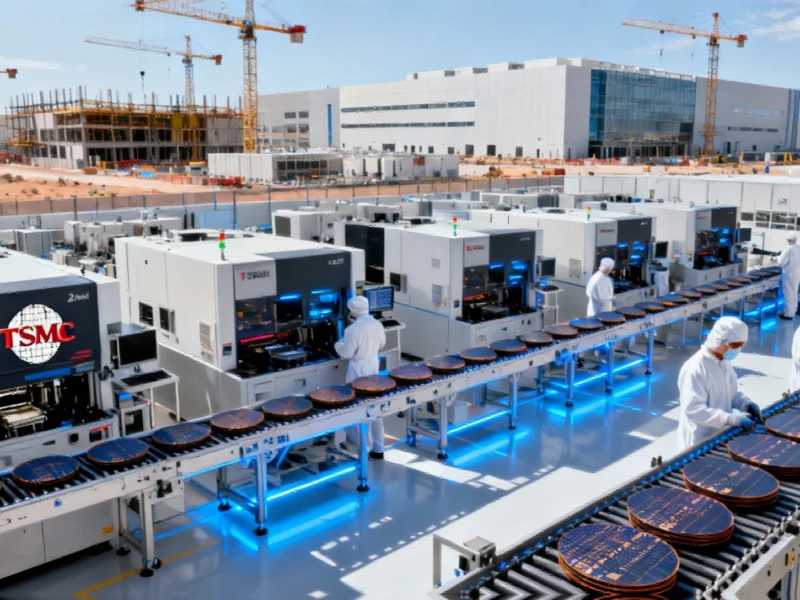TSMC Accelerates U.S. Manufacturing Footprint
Taiwan Semiconductor Manufacturing Company (TSMC) has revealed ambitious plans to significantly expand its American operations during its recent earnings call, marking a strategic shift toward strengthening semiconductor manufacturing capabilities in the United States. The world’s leading foundry is preparing to acquire additional land in Arizona to support new fabrication facilities, responding to unprecedented demand from key U.S. technology partners. This expansion aligns with broader industry trends, including TSMC’s accelerated timeline for bringing cutting-edge semiconductor technology to American soil, as the company positions itself to better serve its North American client base.
The decision comes amid growing demand for advanced chips, particularly those powering artificial intelligence applications. TSMC’s CEO C.C. Wei emphasized the company’s commitment to upgrading its Arizona facilities to produce 2nm (N2) process technology and beyond, representing a significant leap from the current 4nm chips being manufactured at the site. This technological migration mirrors developments in other sectors where major corporations are implementing advanced AI solutions to optimize their operations and maintain competitive advantages.
Driving Forces Behind the Expansion
Several key factors are propelling TSMC’s accelerated U.S. expansion strategy. The insatiable demand for AI-capable semiconductors from American technology giants including NVIDIA, AMD, and Apple has created urgent need for localized advanced chip production. These companies require increasingly sophisticated processors to power next-generation applications, from cloud computing to edge devices.
The geopolitical landscape has also influenced TSMC’s strategic direction, with the U.S. government implementing policies to bolster domestic semiconductor manufacturing through initiatives like the CHIPS Act. This alignment with national security and economic priorities creates favorable conditions for TSMC’s expansion, similar to how technical advancements in AI systems are reshaping multiple industries through improved efficiency and capability.
Technological Timeline and Competitive Positioning
TSMC’s roadmap indicates that 2nm chip production could commence in Arizona as early as the second half of 2026, positioning the company as the second entity after Intel to introduce this advanced node size in the United States. The technological gap between TSMC’s Taiwanese and American facilities is expected to narrow significantly once N2 production begins in Arizona, potentially reducing the current several-year advantage held by the company’s home operations.
Beyond the immediate 2nm plans, TSMC has outlined intentions to scale toward even more advanced A16 (1.6nm) production in Arizona, reflecting the long-term nature of its U.S. commitment. This progression demonstrates how competing technology platforms are driving innovation across the semiconductor industry, with companies racing to deliver increasingly powerful and efficient chips.
Strategic Implications for the Semiconductor Industry
TSMC’s expanded U.S. presence represents a fundamental shift in global semiconductor manufacturing geography. The company’s decision to localize production of its most advanced technologies closer to key customers addresses both supply chain resilience concerns and the specific requirements of American technology firms that constitute a substantial portion of TSMC’s revenue.
The Arizona expansion from the originally planned six fabs to a more comprehensive manufacturing ecosystem underscores the growing importance of geographic diversification in high-tech manufacturing. This strategic move occurs alongside broader industry developments, including increased attention to regulatory frameworks governing advanced technologies and growing awareness of cybersecurity considerations similar to those highlighted in recent major data breach settlements.
Challenges and Opportunities
While TSMC’s U.S. expansion presents significant opportunities, the company faces several challenges in executing its ambitious plans. Establishing advanced semiconductor manufacturing capabilities requires substantial investment in infrastructure, workforce development, and supply chain logistics. The company must navigate these complexities while maintaining its technological leadership and meeting customer expectations.
The success of TSMC’s American operations will depend on multiple factors, including the availability of skilled technicians and engineers, reliable utility infrastructure, and robust supply chains for materials and equipment. These challenges mirror those faced by other industries implementing advanced technologies, where emerging technology platforms can sometimes be exploited by malicious actors, underscoring the importance of comprehensive security measures throughout the manufacturing ecosystem.
Future Outlook
TSMC’s commitment to expanding its U.S. manufacturing capabilities signals a new era in global semiconductor production. The company’s willingness to transfer its most advanced technologies to American soil reflects both market realities and strategic positioning for long-term growth. As AI and other advanced applications continue to drive demand for cutting-edge chips, TSMC’s expanded U.S. presence will play a crucial role in supporting innovation across multiple technology sectors.
The coming years will reveal whether TSMC can successfully scale its American operations to meet escalating demand while maintaining its technological edge. What remains clear is that the geographic distribution of advanced semiconductor manufacturing is undergoing a significant transformation, with implications for global technology leadership, supply chain security, and economic competitiveness.
Based on reporting by {‘uri’: ‘wccftech.com’, ‘dataType’: ‘news’, ‘title’: ‘Wccftech’, ‘description’: ‘We bring you the latest from hardware, mobile technology and gaming industries in news, reviews, guides and more.’, ‘location’: {‘type’: ‘country’, ‘geoNamesId’: ‘6252001’, ‘label’: {‘eng’: ‘United States’}, ‘population’: 310232863, ‘lat’: 39.76, ‘long’: -98.5, ‘area’: 9629091, ‘continent’: ‘Noth America’}, ‘locationValidated’: False, ‘ranking’: {‘importanceRank’: 211894, ‘alexaGlobalRank’: 5765, ‘alexaCountryRank’: 3681}}. This article aggregates information from publicly available sources. All trademarks and copyrights belong to their respective owners.



